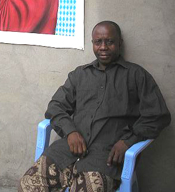 |
|||||||
|
______________________________________________________________________________________________________________________
|
|||||||
| HOME |
|
| ARTISTS
|
|
| CONTACT |
|
| NEWS
|
|
|
BIO | EXHIBITIONS | AVAILABLE WORK
CHÉRI SAMBA, 1956
BIO Chéri Samba was born 1956 in Kinto M’Vuila, Democratic Republic of Congo and currently lives and works in Kinshasa. In
1972 Chéri Samba left school in order to apprentice himself
to the sign painters on Kasa Vubu Avenue in Kinshasa; from this
circle of artists (which included Moke, Bodo, and later Samba’s
younger brother Cheik Ledy among others) arose one of the most
vibrant schools of popular painting in the twentieth century.
Working both as a billboard painter and a comic strip artist, Samba employed the conventions of both genres when he began making paintings on sacking cloth (canvas being too expensive). In 1975 Chéri Samba borrowed from comic art the device of 'word bubbles' which allowed him to interject not only narrative but also commentary into his compositions. Samba has recalled how he came to use text in this paintings: “I had noticed that people in the street would walk by paintings, glance at them and keep going. I thought that if I added a bit of text, people would have to stop and take time to read it, to get more into the painting and admire it. That’s what I called the ‘Samba signature.’ From then on I put text in all my paintings.” In the early 1980s Samba began signing his paintings “Chéri Samba: Artiste Populaire.” Indeed, the popularity of his paintings soon went beyond Kinshasa’s city limits; by the mid 1980s his work was gaining an international audience. Chéri Samba ’s paintings of this period reveal his perception of the social, political, economic and cultural realities of Zaïre (now the Democratic Republic of Congo), exposing all facets of everyday life in Kinshasa. His canvases offer a running commentary on popular customs, sexuality, AIDS and other illnesses, social inequalities, and corruption. Samba has explained, “My painting is concerned with people’s lives. I’m not interested in myths or beliefs. That’s not my goal. I want to change our mentality that keeps us isolated from the world. I appeal to people’s consciences. Artists must make people think.” From the late 1980s on, he himself became the main subject of his paintings. For Samba, this is not an act of narcissism; rather, like an anchor on TV news broadcasts, he places himself in his work to report on what it means to be a successful African artist on the world stage. source: CAACART |
||
|
LINKS
|
|
about
us
| africa
today | artists
| contacts
| painting
|photography
| sculpture
african contemporary - contemporary african art gallery (c) 2017 > All rights reserved | privacy policy |
